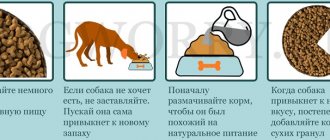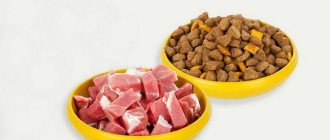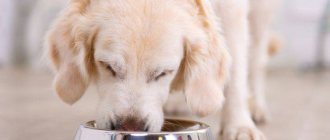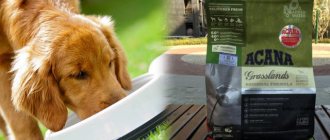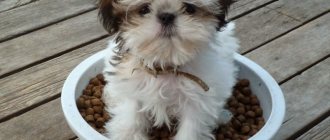Dry or natural: what to choose
Many dog owners, especially newbies, find themselves under information pressure when trying to choose the optimal diet for their dog. Having listened to advertising and advice from experienced dog owners, a novice owner becomes even more confused.
Dry or natural: what to choose? Which food is better and healthier? How do you know if your dog really likes the food?
- Feeding your dog naturally is more natural.
- Dry ready-made food is an alternative for owners who, for some reason, cannot feed their dog suitable natural food.
To be fair, we note that in some situations, feeding industrial products becomes the only alternative to provide your pet with a balanced diet.
Natural feeding
Natural feeding implies the most natural diet possible. Feeding with natural products involves three possible options:
- Raw food diet - feeding only raw foods.
- Meat porridge - feeding the dog a balanced mixture of heat-treated products.
- A mixture of raw and cooked foods is the most common type of feeding.
Important! Dogs are very different from their wild relatives and live in unnatural conditions, so the diet must be tailored to their needs.
Pros and cons of a natural diet
Let's look at the pros and cons of natural hair . Let's start with the advantages:
- Control over the freshness and quality of products.
- Taste variety.
- Possibility to control the caloric content of feed.
- The ability to choose a varied, tasty and gentle diet.
Negative nuances:
- Dog food needs to be prepared separately and regularly - time consuming.
- Products for cooking should be as natural as possible, for example, cottage cheese and other fermented milk products should be prepared at home from whole milk.
- Raw meat can become a source of helminth infection and should be cooked or frozen for 4–5 days.
- Natural food spoils quickly.
Note! Even the most balanced natural diet does not provide the dog with all the necessary vitamins and minerals, so the pet needs to take vitamin courses regularly.
Rules for feeding dogs with natural products
The basic rules of feeding natural products are balance. Statistically, most owners prefer to feed their dog meat porridge.
- For adult dogs, meat porridge is prepared from meat and offal, cereals, vegetables and fruits (33% each). Immediately before serving, vitamin supplements are added to the porridge.
- For puppies, the ingredients of porridge are similar, but the mass fraction of meat should be at least 50–60%.
Important! All foods that can cause allergies are introduced into the diet gradually.
There are many myths associated with milk, which is an important part of a dog's diet. Milk can and should be given to a dog if it tolerates it normally. Approximately 40% of adult dogs develop lactose intolerance, in which case whole milk is replaced with fermented milk products.
Prohibited Products
Prohibited foods in a dog’s natural diet are:
- Alcohol and its derivatives.
- Bones, pure fat, skin, especially poultry.
- Fat meat.
- Palm oil.
- Grapes, raisins.
- Citrus.
- Onion and garlic.
- Persimmon.
- Soy.
- Mushrooms.
- Corn and semolina.
- Raw freshwater fish.
- Dry, salted fish.
- Mayonnaise.
- Products containing hops, tobacco, sugar or its substitutes, xylitol (chewing gum, some sweets), flour or yeast (including yeast dough and dishes made from it), caffeine, cocoa, any stimulants (sweets, tea, coffee, chocolate) , marinades, salt, spices.
- Smoked products, including sausages, balyki, fish.
- Expired products.
- Cat food.
- Leftovers from the table.
You need to be careful with:
- Pork is a source of helminths.
- Raw ocean fish are a source of helminths.
- Whole milk – risk of intolerance.
- Honey is allergenic.
- Chicken eggs are allergenic.
- Raw and boiled chicken liver in large quantities can cause constipation or diarrhea (respectively).
Note! Peaches, plums and other juicy fruits are not prohibited, but can cause diarrhea. The bones can become stuck in the intestinal lumen, leading to obstruction.
An example of a proper menu made from natural products
The daily food intake for a puppy is calculated by weight. The weight of all the food that the baby eats per day should be 7–8% of body weight. For example, let's take the age from 1 to 3 months.
Feeding frequency:
- 1 month – 6 times a day.
- 2 months – 5 times a day.
- 3 months – 4 times a day.
Approximate calculation of food per day for a medium breed puppy aged 1–3 months:
- Meat and offal: 100–400 gr. – mass fraction of by-products no more than 15%.
- Cereals (preferably buckwheat, rice): 80–150 gr.
- Raw and boiled vegetables: 120–200 gr.
- Whole milk: 400–500 ml – in case of individual intolerance (extremely rare under the age of 3 months), milk is replaced with fermented milk products.
- Cottage cheese and fermented milk products: 100–200 gr.
- Chicken or quail egg: 1 chicken yolk or 2 quail eggs.
- Oils and additives: no more than 8 ml in total volume.
An example of the correct menu for a puppy aged 1 to 3 months.
- Early morning: cottage cheese with milk, you can add buckwheat cooked in milk.
- Morning: meat porridge - cereals, vegetables (carrots), meat, offal. Meat component 60%.
- Day: milk, cottage cheese, fermented milk products.
- Afternoon snack: meat porridge.
- Evening: milk porridge (buckwheat/rice/oatmeal) with grated apple, maybe a little kefir, yogurt or fermented baked milk.
- Evening: the meat is clean, raw, after deep freezing for 4–5 days.
Adult dogs eat 2-3 times a day.
For a medium-sized pet (25–30 kg), the approximate daily food intake is made up of:
- Meat and offal and/or fish: 400–500 gr. – by-products no more than 10–15%.
- Cereals (rice, buckwheat, oatmeal, pearl barley): 400–500 gr. – the calorie content of cereals is selected according to individual needs, but it is better to give preference to rice and buckwheat.
- Vegetables and fruits: 300–350 gr. – can be given raw, boiled, steamed.
- Chicken or beef fat: up to 20 gr. – can be replaced with fish oil (2-3 capsules).
- Vitamin supplements: 10–15 g. – can be replaced with industrial vitamin supplements in tablets.
Example menu for an adult dog No. 1:
- Morning: meat porridge – 300 gr. meat, 300 gr. cereals, 200–250 gr. vegetables, vitamin supplements.
- Evening: beef stomach, chopped, 200–350 gr.
Example menu for an adult dog No. 2:
- Morning: milk porridge – 250–300 gr. cereals, 1-2 small apples, chicken or 2-3 quail eggs, cottage cheese 100-150 gr.
- Evening: meat porridge – 300 gr. meat, 300 gr. cereals, 200–250 gr. vegetables, vitamin supplements.
Sample menu for an adult dog No. 3:
- Morning: fish and broth with vegetables (except potatoes) 400–550 gr. in total.
- Evening: raw meat or beef tripe 250–200 g, vitamin supplements.
Note! Due to breed characteristics, the above examples may not be suitable for your pet. Always create a diet based on the preferences and behavior of the ward.
To determine whether the dog is eating the offered portion, it is necessary to monitor the pet’s behavior immediately after eating. Typically, the dog actively absorbs food within 10–15 minutes.
- If there is food left in the bowl 20 minutes after the start of the meal, the portion is too large.
- If the dog finished eating in less than 10 minutes, the portion of food is not enough.
Water intake when feeding natural food
With natural feeding, the water norm is calculated based on the pet’s weight. The minimum daily water intake is 50 ml per 1 kg of body weight. Not drinking enough water can lead to problems digesting food and dehydration. Excessive thirst and water consumption is an alarming symptom.
Exceeding the norm of water consumption by 2 or more times, against the background of a good appetite, may indicate the development of diabetes. Strong thirst is also a symptom of purulent inflammation of the uterus and other inflammatory processes.
In any case, if your dog drinks much more water than he should, be sure to consult a doctor.
Natural nutrition
“Natural” broadly means “real”, “genuine”, “natural”, so the combination of “natural food” sounds very attractive to the caring owner who wants only the best for their pet. However, in reality, this definition may hide a variety of products that are very far from the natural diet of cats and dogs, which should consist mainly of meat.
Very often, “porridge”, which is a kind of Soviet classic of feeding pets, is often mistaken for “natural food”. This dish consisted of 80% cereals or pasta cooked in bone broth with a small amount of meat. The cat version usually contained inexpensive fish like pollock or whiting. Today, scarce times have long passed, however, many adherents of the “old school” of feeding dogs and cats still practice this kind of feeding. Need I say that a food consisting of 80% carbohydrates is simply not able to be properly absorbed in the gastrointestinal tract of a carnivorous predator?
Also, a considerable part of natural nutrition adherents believe that “natural food” is the remains of their own lunch or dinner, roughly speaking, leftovers. Food from the master's table is not suitable for feeding cats and dogs, as it usually contains high amounts of carbohydrates, sugar, salt, fatty or spicy seasonings and sauces.
Only the “natural” version can be beneficial for dogs and cats, consisting of 70-80% raw meat of different varieties, with a small amount of carbohydrates (preferably in the form of vegetables), with the addition of animal fat (for example, fish) and high-quality vitamin and mineral supplements. premix. But if the owner chooses this type of feeding for the pet, he will have to become a real nutritionist for his pet. Independently calculate the calorie content of the diet, the content of proteins, fats, carbohydrates, as well as vitamins and minerals. But even in this case, there is always the possibility that the composition of the “natural” was not sufficiently balanced.
There are other inconveniences that accompany feeding natural food, such as regular large purchases of meat, its subsequent cutting and storage, which will require a lot of space. Raw meat may contain parasites or bacteria, and thermally processed meat is not as nutritious, as many beneficial substances are destroyed during cooking. Natural products have a short shelf life and without refrigeration they spoil very quickly. Feeding your pet “naturally” on the road will be very problematic, and even if you have to leave your pet for several days, finding someone willing to be a personal chef in the service of your pet will be very difficult.
Ready-made dry food
Ready-made dry food is becoming increasingly popular because it saves the owner time. Naturally, not a single, even the highest quality dry food can compare with natural food. However, taking into account all the circumstances and your capabilities, you must choose a diet that best suits your pet's needs.
It is not advisable to change the type of pet’s diet frequently, since this is accompanied by stress and adaptation of the gastrointestinal tract to digest food of an unusual structure.
When choosing an industrial diet, you should sensibly assess your financial capabilities. Many inexperienced owners start feeding their dog dry food, but after 2-3 months they discover that it is too expensive and the pet has to be switched to natural food.
Pros and cons of ready-made feeds
Let's look at the pros and cons of commercial dog food.
Let's start with the advantages:
- No need to waste time cooking.
- It is easy to store and dose - on each package of food there is a recommendation table for calculating the daily intake of food.
- High-quality feed contains all the necessary vitamins and minerals.
Flaws:
- Monotonous food.
- High price – high-quality industrial food costs 2–3 times more than natural feeding.
- Risk of purchasing counterfeit food.
- The need for strict control over water consumption.
If you do not take into account the high price of feed, the advantages of industrial products are very significant.
Important! The dog should not be fed only dry or only wet food. Constant consumption of hard foods leads to rapid deterioration of tooth enamel. Constantly eating only soft foods leads to loosening of the gums, various oral diseases and early tooth loss.
Feed classes
The main criterion for choosing food is its quality. For convenience, the quality of feed is indicated by classes. Main classes of feed:
- Economy - the cheapest and most famous food . The products are not recommended for everyday feeding of pets because they do not contain pure meat, but do contain preservatives, salts, flavor enhancers, flavorings and excessive amounts of carbohydrates.
- Premium food for everyday feeding of healthy, active dogs. The class is characterized by a low content of pure meat and a high content of carbohydrates. The premium segment of feed is the widest, so among feed there are both low-quality and high-quality products.
- Super-premium is the optimal choice for everyday feeding of pets. The products are optimally balanced, contain natural meat, a basic range of vitamins and microelements.
- Holistic - the characteristics do not differ from the super-premium class, but are made from high quality raw materials.
Note! Therapeutic and preventive feeds are produced in the premium segment and above.
Super-premium and holistic food differ significantly in price, and many owners cannot make a final choice. In fact, it is better to constantly feed your dog high-quality super-premium food than to periodically feed it holistically.
The main difference between holistic foods and other foods is that they are made from products that are suitable for human consumption.
Note! Grain-free foods contain more meat and are produced in the super-premium and holistic classes.
Always read the ingredients of a product before purchasing it.
- For premium class, a good indicator is 30% meat or more.
- For super-premium and holistic class feeds – 40–45% meat.
- For grain-free feeds – 50–60% meat.
- The calorie content of good feed varies from 350 to 450 kcal/100 g.
Advice: if you find unclear formulations, products unfamiliar to you, or do not find the percentage of ingredients in the food, it is better not to purchase it.
Choosing the right dog food
When we select the right food for a dog, size, activity and age must be taken into account. Some manufacturers produce food for specific breeds, focusing on coat length or individual needs.
Everyday food for small breed dogs:
- Acana Heritage Adult Small Breed is a holistic food for adult small breed dogs.
- Royal Canin X-Small adult is a premium food for small dogs over 10 months old.
- Bosch Breeder Line Puppy Lamb & Rice is a premium food for small breed puppies.
Everyday food for medium breed dogs:
- Orijen Original is a holistic food for adult dogs.
- ProPlan Puppy Medium is a premium food for medium breed puppies.
- Hill's SP Canine Performance is a premium food for medium-sized, active dogs.
Everyday food for large breed dogs:
- Grandorf Lamb & Rice Adult Large Breed is a holistic food for adult, large dogs.
- Royal Canin Giant Puppy is a premium food for active large breed puppies.
- Brit Care Adult Large Breed Salmon & Potate is a grain-free super-premium food for large and giant dogs.
Food for dogs over 7 years of age:
- Orijen Senior is a holistic food for older dogs.
- Pronature Holistic Dog Adult All Breeds Indoor & Outdoo is a holistic food for older or inactive dogs.
- Josera Balance is a premium food for older dogs.
Food for dogs with special needs:
- Acana Light&Fit – holistic food for overweight dogs
- Nutram Ideal Adult Sensitive is a holistic food for dogs with sensitive skin.
- Royal Canin Gastro Intestinal Junior is a premium food for dogs with sensitive digestion.
Advice: when choosing food from well-known brands, pay attention to the appearance of the packaging and the completeness of the information on the back. Popular foods are often counterfeited; this is a direct threat to your pet's health.
Water norm when feeding dry food
When feeding dry food, the water norm is calculated from the ratio of 100–150 ml per 1 kg of body weight. It is extremely important to provide your pet with free access to water. If there is a risk that the dog will not have access to water, additional drinking bowls must be placed in the home.
If a dog eats dry food and regularly receives less water than it should, it will become dehydrated.
Slight dehydration over an extended period of time leads to a slower metabolism, which is detrimental to a dog's overall health. Severe dehydration leads to blood thickening, which can lead to oxygen starvation of tissues and organs.
Mixed feeding - pros, cons, recommendations from veterinarians
Mixed feeding involves preparing a diet from ready-made feed and natural products. According to the recommendations of veterinarians and manufacturers of prepared animal feed, mixed feeding should not be practiced on an ongoing basis.
A dog's digestive system operates in a stable manner if it digests food in the same structures. Dry food and natural products take different amounts of time to digest, so with mixed feeding, some of the food is not digested. Regular rotting of part of the food eaten in the intestines leads to the death of friendly bacteria and their replacement by pathogenic microflora (dysbacteriosis).
Mixed feeding is allowed if the dog receives homogeneous food. Simply put, before feeding, dry food needs to be soaked. However, this type of feeding can lead to sudden weight gain, metabolic problems, and excess vitamins and microelements.
Mixed nutrition
Most veterinarians and owners believe that this type is unacceptable. By mixed, many understand options in which dogs receive dry food in the morning feeding, and in the evening a portion of porridge with meat, or the products are mixed directly in one bowl. It is unlikely that any animal will be able to digest such a diet without causing serious problems with the gastrointestinal tract.
Many breeders have developed their own mixed type rules:
- dry food + meat products, fermented milk, vegetables or fruits in one bowl;
- Cereals are not used in such feedings.
Such nutrition will not create a significant burden on the gastrointestinal tract, since a dog needs different doses of acids and types of enzymes to digest dry food and porridge.
There are nurseries that use a mixed type, but with one caveat: dry food is soaked, meat is eaten boiled. If meat is given raw, this should be a separate feeding. For example, evening.
Interesting fact: dry food manufacturers themselves allow a mixed type of feeding - granules + wet canned food.
Advantages and disadvantages
| pros | Minuses |
|
|
Puppy's first feeding
At the age of 1–1.5 months, puppies open their eyes and become interested in adult food. The choice of the puppy's first complementary food depends on the type of feeding.
If the puppy was fed by its mother, it is fed:
- Whole goat or cow's milk.
- Low-fat broth.
- Boiled minced meat mixed with broth.
When bottle-fed, the puppy is fed industrially produced pates or pastes. If the baby is stunted, canned food for malnourished animals is used as the first complementary food.
Rules for transferring an adult dog to dry food
If you decide to switch your dog to dry food from natural food, it is important not to rush. The digestive system needs some time to adapt to digesting food with an unusual structure.
Rules for transferring an adult dog to dry food:
- If your dog categorically refuses pellets, switch him to canned food. Start mixing canned food into your usual porridge. Gradually increase the mass fraction of canned food to 75% of the daily food intake.
- Once your dog starts eating canned food willingly, start adding soaked dry food granules to it. The food is poured with warm water 10–15 minutes before serving. After the granules become soft, they are mixed with canned food until smooth.
- After getting used to the soaked food, the granules are given in dry form. In the first few days, feed granules from the palm of your hand, this will make the dog more willing to consume the new food. Afterwards, gradually increase the mass fraction of dry granules from 15 to 75% of the daily feed intake.
The final diet of an adult dog consists of 75% dry and 25% wet food. These proportions may vary depending on the dog's needs, but dry food should not be less than 50%. Feeding only canned food is acceptable for puppies and very elderly dogs.
What to feed a dog, the opinion of veterinarians
There is no clear opinion among veterinary specialists regarding the choice of type of feeding; each of them proceeds from their own experience. Most of them select the patient's menu together with the owner.
Here are some opinions:
Ivan S, veterinarian, 8 years experience
“I suggest my clients start feeding their puppies with dry and wet food, choosing exclusively super-premium classes. From experience, some owners simply forget about the need for additional support of the body with vitamins when feeding natural food, or simply save on it. We often change dry food if problems arise or the pet refuses to eat one or another type. Using a ready-made diet, it is easier to choose a diet for obesity, or choose an option for an allergy sufferer or an older dog. In this option, the owners are more disciplined with their dog - they do not give food from the table.”
Elena K., veterinarian, 12 years experience
“I am a supporter of natural nutrition, with a high content of meat in dog food. Since the advent of dry food, the number of kidney diseases and urolithiasis has seriously increased. Problems with inflammation of the paraanal glands - feces are too soft in consistency. Naturally, natural food is only for owners who are ready for problems with nutrition. If I see that the pet has been switched to full plates of empty porridge with a small amount of vegetables, I recommend dry food.”
Oleg, veterinarian with 6 years of experience
“Even during our studies, we were told that a mixed meal option should not be recommended to owners, since the dog’s gastrointestinal tract simply cannot cope with the constant process of digestion. But with a competent approach, choosing the diet and system together, we came to the conclusion that mixed options are often an excellent solution. The dog will receive everything it needs. It will not burden the gastrointestinal tract and will avoid most of the problems inherent in the same type of feeding.”
